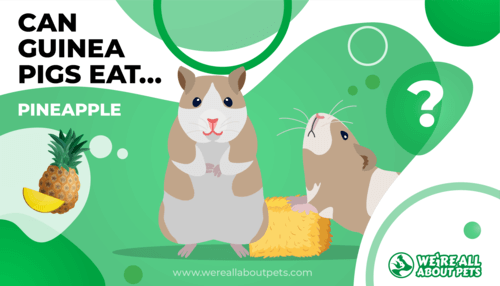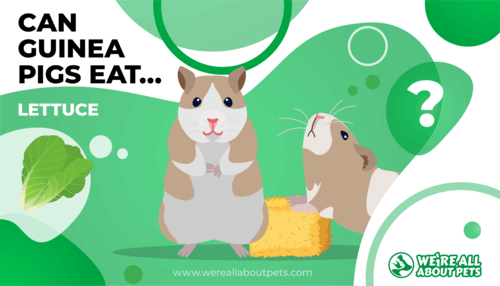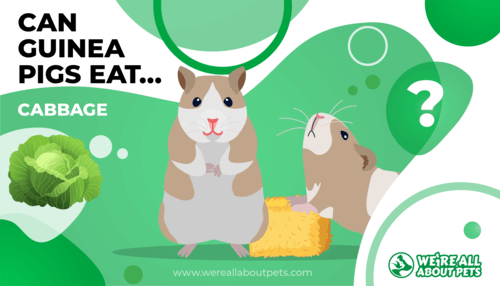13 Types of Guinea Pigs Breeds That Make Great Pets
This page contains affiliate links. We may earn money or products from the companies mentioned in this post through our independently chosen links, which earn us a commission. Learn More
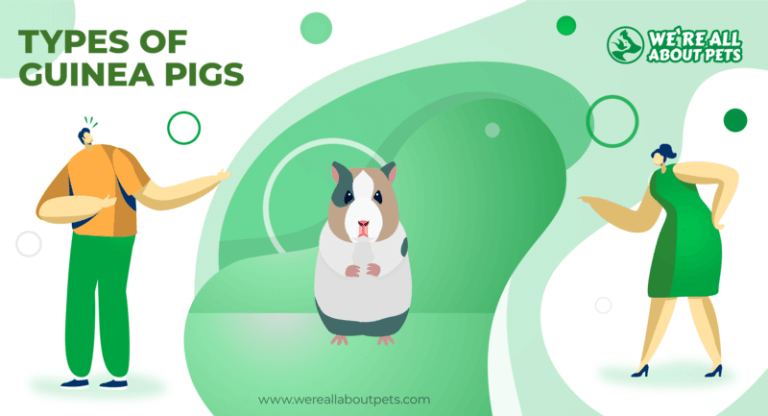
When you take a trip to the pet store, it’s hard to resist walking through the small animal section to visit the furry critters. In addition to hamsters, gerbils, and ferrets, no pet store would be complete without a guinea pig or two. You may even stumble across a hairless guinea pig or skinny pig!
Guinea pigs make wonderful pets because they are fairly small, easy to care for, and gentle in demeanor. Small as they may be, however, guinea pigs can be very loud when they want to be, and they can be quite active and more than a little bit goofy.
Though all guinea pigs come from the same domesticated breed (Cavia porcellus), there are a variety of guinea pig breeds to choose from. Read on to learn about the options.
13 Types of Guinea Pigs
If you don’t know anything about guinea pigs, you might assume that they are somehow related to pigs simply because of their name. The common name actually comes from their scientific name, however, which is Cavia porcellus. The guinea pig is also known as the cavy for the same reason.
All guinea pigs come from the same domesticated species, but different breeds of guinea pig do exist. The American Cavy Breeders Association, an adjunct to the American Rabbit Breeders Association (ARBA) recognizes 13 guinea pig breeds and a wide variety of color combinations.
Here’s a quick overview of some of the most popular types of guinea pigs:
1.Abyssinian
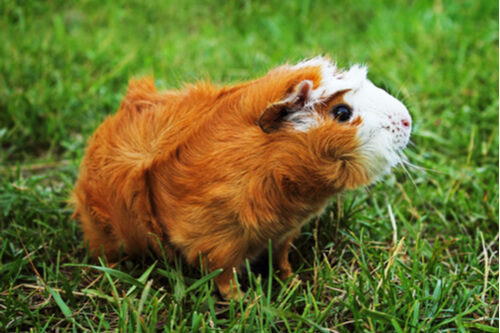
- Origin: South America
- Price: $10 to $40
- Size: Up to 2.5 pounds
- Fur: Short, rosettes
The Abyssinian guinea pig is known for the rosettes in its coat. In a show cavy, there are 10 rosettes in specific locations: four on the saddle, two on the shoulders, two on the hips, and two on the rump. Abyssinian guinea pigs should have rounded rosettes with pinpoint centers and ridges between the rosettes, according to the ARBA breed standard. The coat should be less than 1.5 inches in length.
2.Abyssinian Satin
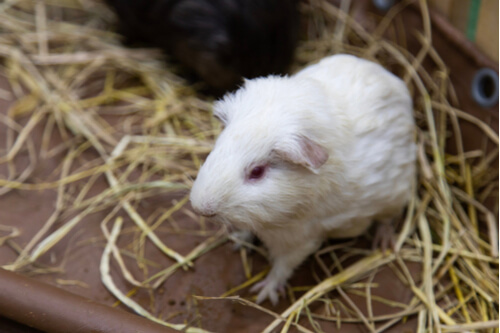
- Origin: South America
- Price: $10 to $40
- Size: Up to 2.5 pounds
- Fur: Short, rosettes, satin sheen
Satin guinea pigs are not a separate breed, it’s just a distinction in the coat. On a true satin guinea pig, the hair shaft is actually hollow which gives it a glassy sheen. Abyssinian satin guinea pigs have the characteristic array of rosettes and come in the same variety of colors.
3.American
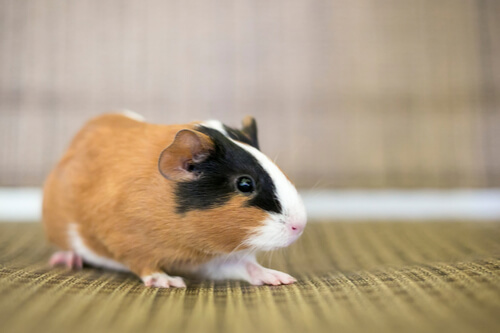
- Origin: South America
- Price: $10 to $40
- Size: Up to 2.5 pounds
- Fur: Short, any color
The most common breed in the United States, the American guinea pig has a silky, short coat in just about any color. These guinea pigs have broad shoulders with a full crown and Roman nose. The eyes should be bold and bright, the ears drooping but not fallen. American guinea pigs are known for their sweet personalities which is what makes them a favorite.
4.American Satin
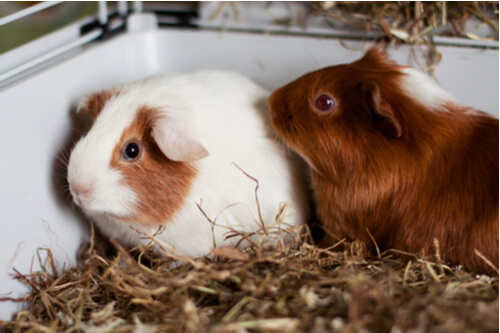
- Origin: South America
- Price: $10 to $40
- Size: Up to 2.5 pounds
- Fur: Short, any color, satin sheen
Similar to the Abyssinian satin guinea pig, the American satin is the same as the American, but the short coat has a satin sheen. The gene responsible for the satin coat is recessive and can be found in all coat types: rough, curly, short, and long. The satin coat is also linked to an incurable metabolic bone disease called osteodystrophy which is why some guinea pig associations refuse to show satin varieties.
5.Coronet
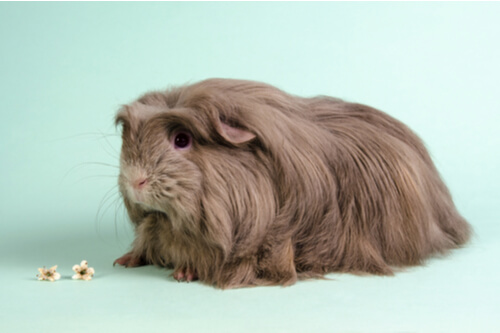
- Origin: South America
- Price: $10 to $40
- Size: Up to 2.5 pounds
- Fur: Long
The coronet guinea pig is one of several long-haired breeds. These guinea pigs have a smooth coat that grows backward over the body with a crest on the forehead. Similar to short-haired guinea pig breeds, this crest should be symmetrical and very distinct with a small center.
6.Peruvian
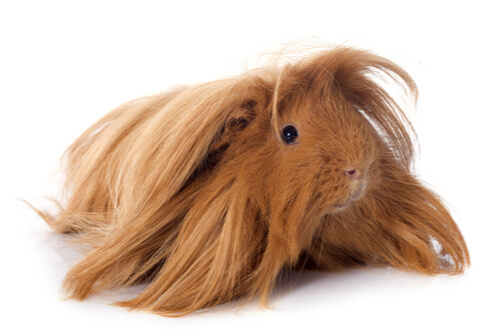
- Origin: South America
- Price: $10 to $40
- Size: Up to 2.5 pounds
- Fur: Long, smooth
The Peruvian guinea pig is another long-haired guinea pig. This breed has a smooth coat all over the body like the coronet guinea pig, but it has a prominent forelock rather than a crest on the forehead. The forelock is the result of a part of the coat on the head and neck growing forward over the body while the rest of the coat grows backward.
7.Peruvian Satin
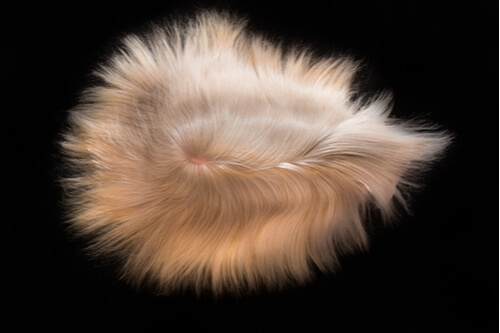
- Origin: South America
- Price: $10 to $40
- Size: Up to 2.5 pounds
- Fur: Long, smooth, satin sheen
Again, this is a satin version of the Peruvian guinea pig. Peruvian guinea pigs typically exhibit one or two colors – tri-colored Peruvians are quite rare. The most common colors for Peruvian guinea pigs are white, light brown, dark brown, and black.
8.Silkie
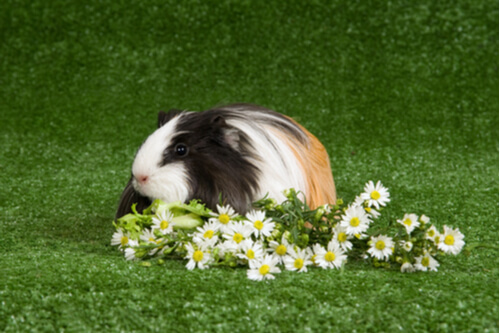
- Origin: South America
- Price: $10 to $40
- Size: Up to 2.5 pounds
- Fur: Long, smooth
The silkie guinea pig is also known as the sheltie and has a long, smooth coat that grows backward over the body. What distinguishes this breed from the other long-hair guinea pigs is that its coat doesn’t have a part. Viewed from above, silkie guinea pigs and their coats form a teardrop shape.
9.Silkie Satin
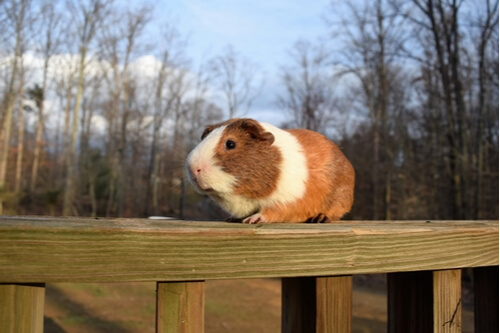
- Origin: South America
- Price: $10 to $40
- Size: Up to 2.5 pounds
- Fur: Long, smooth, satin sheen
The silkie satin guinea pig has the same coat but with a satin sheen. This guinea pig breed typically has a longer sweep of hair in the rear and it must never have any rosettes or hair growing toward its face.
10.Teddy
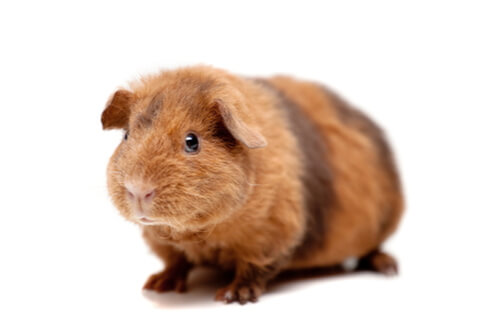
- Origin: South America
- Price: $10 to $40
- Size: Up to 2.5 pounds
- Fur: Short, rough, dense
The teddy guinea pig has a short coat, but its texture is very different from other breeds. They have a rough, dense coat that is quite springy, standing up all over the body. Teddy guinea pigs also have fairly long hair covering their bellies which is unique to the U.S. variety.
11.Teddy Satin
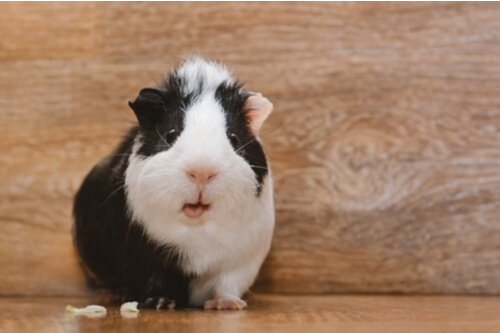
- Origin: South America
- Price: $10 to $40
- Size: Up to 2.5 pounds
- Fur: Short, dense
Teddy satin guinea pigs have the same dense, springy hair but it has a satin sheen to it. The teddy and the teddy satin are the only two plush-coated guinea pigs.
12.Texel
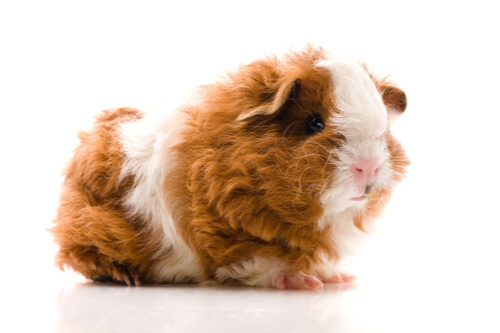
- Origin: South America
- Price: $10 to $40
- Size: Up to 2.5 pounds
- Fur: Long, curly, coarse
Perhaps the most unique-looking guinea pig is the Texel. Originally bred in Britain, the Texel guinea pig has a long coat of coarse, curly hair. The curls are not quite ringlets and tend to be a little looser and shorter around the face.
The merino or English merino guinea pig is a Texel breed of guinea pig with a crown on its head. It is a recognized breed in Europe.
13.White-Crested
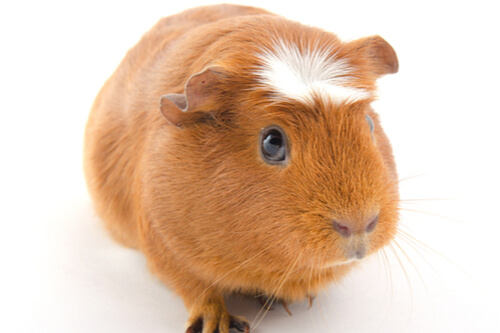
- Origin: South America
- Price: $10 to $40
- Size: Up to 2.5 pounds
- Fur: Short, any color, white crest
The white crested guinea pig is very similar to the American guinea pig but has a single white rosette on the forehead. The breed standard for the two is nearly identical, minus the color distinction. According to the ACBA breed standard, only the crest should be white – there shouldn’t be white anywhere else.
Other Guinea Pig Types
In addition to these 13 breeds of guinea pig recognized by the ARBA, there are a few other types worth mentioning. The skinny pig is a mostly hairless guinea pig that has some short hair on its feet and face. Similar to the skinny guinea pig, the Baldwin guinea pig breed ends up being hairless but is born with a full coat.
The Lunkarya group of guinea pigs were developed in Sweden and is primarily seen in Nordic countries. These guinea pigs have long, rough, and curly coats with three variations: the Lunkarya Peruvian, Lunkarya Sheltie, and Lunkarya Coronet.
In Australia, the Sheba or Sheba Mini Yak is a recognized breed. This long-haired guinea pig breed has rosettes and “mutton chop” whiskers. It is sometimes referred to as the “bad hair day cavy” due to its naturally tousled appearance.
The Benefits of Owning a Pet Guinea Pig
All pets have their pros and cons but it’s difficult to name anything about guinea pigs that is particularly bad. These small pets are gentle, low maintenance, and very entertaining.
Here are some of the benefits of guinea pigs as pets:
- The cost to keep guinea pigs as pets is fairly low because they don’t require much other than a spacious cage and a healthy diet. They are very active, however, so it’s worth investing in a larger cage rather than skimping with a smaller, cheaper one.
- Guinea pigs are very sweet and docile by nature, though temperament varies to some degree by breed. These small animals make good pets for responsible children.
- Maintaining a guinea pig cage is fairly easy if you choose the right bedding. Using the right bedding controls moisture and odor so you really only need to clean out the cage a few times a month. This depends on the size of the cage and the number of guinea pigs, of course.
- Guinea pigs can be surprisingly entertaining as pets. Not only do they make funny noises when they are hungry or excited, but they are very active and exhibit unique behaviors like squealing and “popcorning.” They can even be trained to some degree.
- A guinea pig’s diet is very straightforward and inexpensive to maintain. The staple of the diet is fresh grass hay supplemented with commercial timothy hay pellets and fresh foods daily.
Guinea pigs are simple creatures – it doesn’t take much to make them happy. As long as they have a spacious cage with plenty of hay, unlimited fresh water, and an assortment of toys to play with (not to mention your love and attention, of course) your pet will be perfectly happy!
What to Know Before Getting a Pet Guinea Pig
While guinea pigs are generally fairly easy pets to keep, there are still some things you should know. It’s important to do your research and be prepared, no matter what type of pet you choose.
Here are some other important things to consider for pet guinea pigs:
- While guinea pigs are very gentle with people, they can be aggressive when multiple male guinea pigs are kept together. Guinea pigs will establish a pecking order which can sometimes get violent, but once the order is established things should settle down.
- Guinea pigs are very active animals and need plenty of space to run. It is more important to provide a large open area than to provide multiple levels. A large, single-level cage with plenty of toys and a few places to hide is ideal.
- Like many rodents, guinea pigs will breed prolifically if given the chance. It’s important to keep the sexes separated, as even juvenile guinea pigs will mate as young as 3 months of age.
- Because guinea pigs need a lot of exercise, you may want to consider getting a guinea pig playpen to take your pet outside or into the living room for a little free time. Having a playpen to give your pet space to run and play means you may be able to get away with a smaller cage.
- Guinea pigs have very sensitive digestive systems, so it’s important to provide the right type of diet. These animals need a great deal of fiber with moderate amounts of protein and low fat.
Whether you’re a first-time pet owner yourself or shopping for your child, a guinea pig is a great option to consider. Just keep in mind that all pets require a certain degree of care and commitment.
Take what you’ve learned here to decide which type of guinea pig to get.






